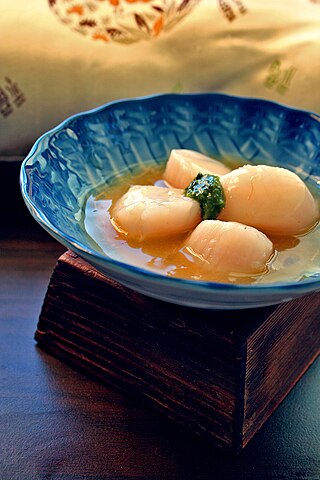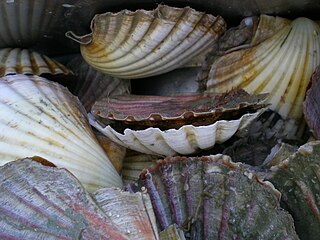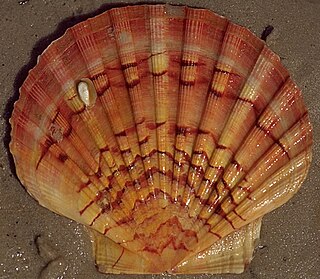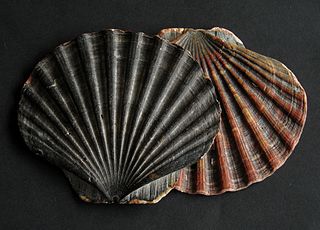
Scallop is a common name that encompasses various species of marine bivalve mollusks in the taxonomic family Pectinidae, the scallops. However, the common name "scallop" is also sometimes applied to species in other closely related families within the superfamily Pectinoidea, which also includes the thorny oysters.

Utopia Planitia is a large plain within Utopia, the largest recognized impact basin on Mars and in the Solar System with an estimated diameter of 3,300 km (2,100 mi). It is the Martian region where the Viking 2 lander touched down and began exploring on September 3, 1976, and the Zhurong rover touched down on May 14, 2021, as a part of the Tianwen-1 mission. It is located at the antipode of Argyre Planitia, centered at 46.7°N 117.5°E. It is also in the Casius quadrangle, Amenthes quadrangle, and the Cebrenia quadrangle of Mars.
The fingerboard is an important component of most stringed instruments. It is a thin, long strip of material, usually wood, that is laminated to the front of the neck of an instrument. The strings run over the fingerboard, between the nut and bridge. To play the instrument, a musician presses strings down to the fingerboard to change the vibrating length, changing the pitch. This is called stopping the strings. Depending on the instrument and the style of music, the musician may pluck, strum or bow one or more strings with the hand that is not fretting the notes. On some instruments, notes can be sounded by the fretting hand alone, such as with hammer ons, an electric guitar technique.

Conpoy or dried scallop is a type of Cantonese dried seafood product that is made from the adductor muscle of scallops. The smell of conpoy is marine, pungent, and reminiscent of certain salt-cured meats. Its taste is rich in umami due to its high content of various free amino acids, such as glycine, alanine, and glutamic acid. It is also rich in nucleic acids such as inosinic acid, amino acid byproducts such as taurine, and minerals, such as calcium and zinc.

A scalloped margin dome is a type of volcanic dome, found on Venus, that has experienced collapse and mass wasting such as landslides on its perimeter. The margins of these domes have arcuate headscarps or 'scallops' separated by ridges that are a consequence of adjoining scallops. Sometimes debris or slumping can be found at the bottom of these scarps or scattered many tens of kilometers away. Many examples show no debris at all. The center of these domes is often, but not always, a depression. There is another theory that the radial ridges of scalloped margin domes are volcanic dikes.

The scalloped hammerhead is a species of hammerhead shark in the family Sphyrnidae. It was originally known as Zygaena lewini. The Greek word sphyrna translates into "hammer" in English, referring to the shape of this shark's head, which is its most distinguishing characteristic. The shark's eyes and nostrils are at the tips of the extensions. It is a fairly large hammerhead, but is still smaller than both the great and smooth hammerheads.
Potato cake is a name given to various shaped potato dishes around the world, including a patty of hashed potatoes, a fried patty of mashed potato, a fried and battered slice of potato, or a flatbread made with mashed potato and flour. In Northern England and some states in Australia, a thin slice of potato that is battered and deep fried may be called a potato scallop. In Australia and New Zealand, the terms potato cake, potato flip and potato fritter may be used.

Aequipecten is a genus of scallops, marine bivalve mollusks in the family Pectinidae.

Pecten novaezelandiae, common name the New Zealand scallop, is a bivalve mollusc of the family Pectinidae, the scallops. Its name is sometimes found misspelt as Pecten novaezealandiae.

Pecten jacobaeus, the Mediterranean scallop, is a species of scallop, an edible saltwater scallop, a marine bivalve mollusc in the family Pectinidae, the scallops.

A fishing dredge, also known as a scallop dredge or oyster dredge, is a kind of dredge which is towed along the bottom of the sea by a fishing boat in order to collect a targeted edible bottom-dwelling species. The gear is used to fish for scallops, oysters and other species of clams, crabs, and sea cucumber. The dredge is then winched up into the boat and emptied. Dredges are also used in connection with the work of the naturalist in marine biology, notably on the Challenger Expedition.

Chlamys is a genus of small scallops, marine bivalve molluscs in the family Pectinidae. The name is taken from the Ancient Greek, χλαμΰς or Chlamys, a cloak worn by soldiers.

Pecten maximus, common names the great scallop, king scallop, St James shell or escallop, is a northeast Atlantic species of scallop, an edible saltwater clam, a marine bivalve mollusc in the family Pectinidae. This is the type species of the genus. This species may be conspecific with Pecten jacobaeus, the pilgrim's scallop, which has a much more restricted distribution.

Argopecten irradians, formerly classified as Aequipecten irradians, common names Atlantic bay scallop, bay scallop, and blue-eyed scallop, is a species of scallop in the family Pectinidae. An edible saltwater clam, it is native to the northwest Atlantic from Cape Cod to the Gulf of Mexico.

Peneus Patera is a feature in the Noachis quadrangle of Mars. It is located at 58.1 S and 307.5 W. It was named after an albedo feature at 48S, 290W.
Scalloped topography is common in the mid-latitudes of Mars, between 45° and 60° north and south. It is particularly prominent in the region of Utopia Planitia, in the northern hemisphere, and in the region of Peneus and Amphitrites Paterae in the southern hemisphere. Such topography consists of shallow, rimless depressions with scalloped edges, commonly referred to as "scalloped depressions" or simply "scallops". Scalloped depressions can be isolated or clustered and sometimes seem to coalesce. A typical scalloped depression displays a gentle equator-facing slope and a steeper pole-facing scarp. This topographic asymmetry is probably due to differences in insolation. Scalloped depressions are believed to form from the removal of subsurface material, possibly interstitial ice, by sublimation. This process may still be happening at present. This topography may be of great importance for future colonization of Mars because it may point to deposits of pure ice.

Argopecten purpuratus is an edible marine species of saltwater shellfish, a bivalve mollusk in the family Pectinidae.

Placopecten magellanicus, previously listed as Pecten tenuicostatus and as Pecten grandis and once referred to as the "giant scallop", common names Atlantic deep-sea scallop, deep sea scallop, North Atlantic sea scallop, American sea scallop, Atlantic sea scallop, or sea scallop, is a commercially important pectinid bivalve mollusk native to the northwest Atlantic Ocean.

Scallop aquaculture is the commercial activity of cultivating (farming) scallops until they reach a marketable size and can be sold as a consumer product. Wild juvenile scallops, or spat, were collected for growing in Japan as early as 1934. The first attempts to fully cultivate scallops in farm environments were not recorded until the 1950s and 1960s. Traditionally, fishing for wild scallops has been the preferred practice, since farming can be expensive. However worldwide declines in wild scallop populations have resulted in the growth of aquaculture. Globally the scallop aquaculture industry is now well established, with a reported annual production totalling over 1,200,000 metric tonnes from about 12 species. China and Japan account for about 90% of the reported production.

Mizuhopecten yessoensis is a species of marine bivalve mollusks in the family Pectinidae, the scallops. Its name Yesso/Ezo refers to its being found north of Japan.














